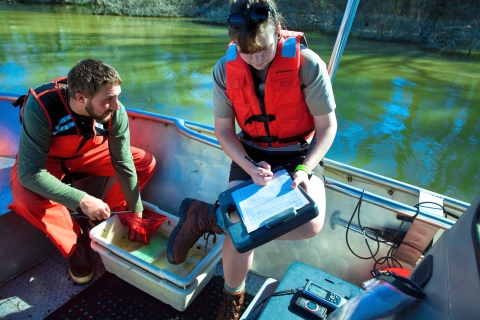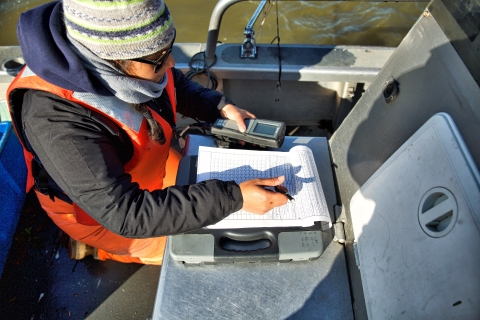Shortly after 6 a.m., boat crews with the U.S. Fish and Wildlife Service head out from their Lodi office to that day’s targeted locations around the Delta, capturing more information on the Delta smelt than has ever been available before.
The new Enhanced Delta Smelt Monitoring Program (EDSM) has only been operational since mid-December, but staff of both the Lodi and Bay-Delta Fish and Wildlife Offices met the challenges they faced in getting the new survey program up and running as the water-starved Bay-Delta region was being doused with record early season rains.
“It’s running very smoothly now,” said Julie Day, the Delta Juvenile Fish Monitoring Program manager in the Lodi office, who is implementing the program.
Day’s sigh of relief is justified. Her office had to replace key staff while adding others to gear up for the program’s rigorous schedule. She deploys multiple crews a day to randomly selected locations that change every day, with crews of three to five people trawling 24 to 36 sites per week.
The crews – consisting of full-time technicians and boat operators, biologists and statisticians –spend up to 12 hours a day on the water, conducting as many as eight net tows at each location. Each tow is limited to less than 10 minutes to avoid damaging fish or catching too many.
This hectic schedule runs Monday through Thursday, with sometimes Fridays thrown in, virtually year-round, in all weather conditions. The monitoring program’s goal is to gather information on the controversial three-inch fish whose numbers have plummeted to record low levels in recent years.
“It was a brand new program for us that had to come on line very quickly,” Day said.
The need for more data resulting from the new monitoring program has been widespread.
Elected officials, water managers and scientists working on Delta smelt have all sought additional information on this species that lives just a year, is found only in the San Joaquin-Sacramento Delta system, and had become a central figure in the California water picture.
Several data-gathering surveys have historically provided information used in numerous ways, such as state-run fish fall and spring annual surveys, which have the ability to show seasonal abundance estimates and distribution of Delta smelt. But those surveys haven’t always provided the real-time data water managers needed to make timely decisions.
Three years ago, the Service, with the cooperation of other state and federal water agencies, began an early warning monitoring program which provided the Service, and state and federal water managers valuable near real-time information about the location of Delta smelt. Those surveys were a breakthrough at the time, and meant to give water project managers additional time to adapt pumping operations should the imperiled fish move closer to water diversions in the southern Delta.
The program was successful, but only went so far, with sometimes just one survey a week occurring at the same locations during those periods the Delta was facing one of its many dry stretches.
“The early warning program generally only yielded information about fish densities at two locations on the lower San Joaquin River – Jersey Point and Prisoners Point, and how those densities changed over time,” Day said.
“In contrast,” she continued, “the EDSM not only provides that same information, but it will also put those changes in perspective by providing information about fish abundances throughout the entire range of Delta smelt.“
According to Ken Newman, the Service's statistician whose models have provided the framework for Delta smelt monitoring, portions of the new survey grew from a proposal that changed how to assess salvage risks at the state and federal pumping operations near Tracy.
“Instead of focusing on the adult Delta smelt collected at the fish salvage facilities near the export pumps for assessing entrainment risk, we proposed it would be better to have an idea of the approximate proportion of the adult Delta Smelt population that is being lost, or at least at risk of being lost to the population,” Newman said.
Research indicated that the current state fish survey programs were showing a number of "false negatives," meaning a sample would show there weren’t any Delta smelt caught when in fact some were known to be present in the area.
The enhanced monitoring effort can also pinpoint fish locations and changes in density.
A new feature of the program, said Day, is random site selection for the surveys.
With some of the current surveys, the same sampling locations chosen back in the 1950s were still being visited month after month. Today, sampling areas are broken down into more specific sub-regions.
“That means every day we’re going somewhere different and somewhere that hasn’t been sampled before,” Day said. “Decision makers will have estimates of the fraction of the total population present in specific sub-regions, how those fractions are changing over time, and what fraction of the population might be affected by management actions,” she said.
Crews have used two different survey models based on the time of year and gear requirements. The first survey ran until the end of March, and targeted adult Delta smelt. The second model switched to a finer mesh netting, so it can capture the smaller 20 millimeter juveniles and larvae, Day said.
Data from this work will also help inform how operational adjustments can be made to better balance risk to Delta smelt and important water supplies.






